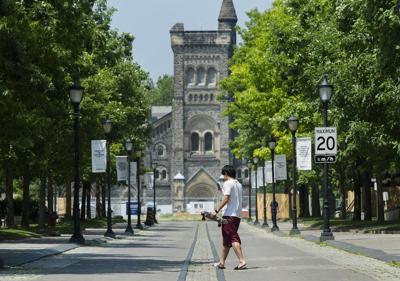Ontario universities and colleges face an influx of 225,000 additional students over the next two decades, but without proper funding teens could be left “without access to their preferred programs,” warns a new report from the government’s own post-secondary research office.Â
Calling it a “pivotal moment” as numbers are expected to rise by 45 per cent, “these enrolment increases add to the pressures the sector is already facing: an ongoing tuition freeze, static operating grants, restrictions on international student enrolment, and a funding model that limits enrolment growth,” said the , also known as HEQCO.
“Without planning and funding for the estimated 225,000 new domestic (post-secondary) seats required by 2046, students in Ontario may find themselves in a highly competitive environment, leaving them without access to their preferred programs.”
A new report shows that Ontario universities’ share of extra funding is $148 million for
The report, released last week, comes as colleges and universities cut classes, staff and even shutter campuses — just last month Centennial College announced it will close one in East York following news that it plans to suspend more than a quarter of overall programming. York University faces a $100-million-plus operating deficit.
The province has provided $1.3 billion in additional funding to schools over three years to address financial struggles, though in 2023 an expert panel it appointed recommended about double that.
“Our government is taking decisive action to get Ontario students into rewarding careers that address the province’s current and future labour market needs,” said Bianca Giacoboni, press secretary to Colleges and Universities Minister Nolan Quinn.
“As our latest step to protect Ontario, we are investing over $500 million to fund thousands of STEM and skilled trades seats at Ontario colleges and universities, strengthening the pipeline of highly skilled workers that will drive our economy across critical sectors,” she said, referring to the government’s focus on science, technology, engineering and math (STEM) education.
At the same time, an application for judicial review by a group of York U senators claims the
“Coupled with our record-setting investment of $1.3 billion last year, and on top of the $5 billion we put into the sector every year, we are ensuring Ontario continues to deliver a world-class education for our students.”
The post-secondary sector was hit with a tuition cut of 10 per cent in 2019 and a subsequent freeze in fees that continues to this day. It’s also being affected by stagnant provincial funding amid inflation, as well as cuts to the number of international students — who pay double or triple the tuition of domestic students — imposed by the federal government.Â
Maureen Adamson, president and CEO of Colleges Ontario, said that “in the absence of much-needed funding for Ontario’s public colleges that addresses structural deficits, labour shortages and the impact of tariffs on the economy, colleges across the province will be forced to suspend more programs, close more campuses and more jobs will be lost.”
College grads, she added, “meet labour demands in advanced manufacturing, carpentry, mining, applied technology and health care — all priority areas for the province.”
(However, amid their ongoing financial troubles, some institutions have come under fire for providing above-average raises to their leaders.)
Just last year, the Council of Ontario Universities said schools needed the government to lift a cap on domestic enrolment and fully fund those students otherwise 100,000 spots over the next 10 years would be at risk.Â
Schools are also funded using a model that forces them to cover the costs of any students who are above a set “corridor” range, and they’ve been urging changes, as does the HEQCO report.
Many schools described the impact of the study permit changes as significant to severe, paired
Steve Orsini, president and CEO of the Council of Ontario Universities, said the province’s students “are voting with their feet. In fact, our universities have seen a dramatic increase in the demand by Ontario high school students wishing to attend an Ontario university. Since 2020, Ontario high school applicants have increased by 16.7 per cent.Â
“As a result of this increased demand by domestic students for a limited number of spaces, Ontario high school students are experiencing greater difficulties in enrolling in a program of their choice,” which HEQCO has confirmed, he said, adding that there are currently more than 28,000 domestic students unfunded by the province, costing schools $200 million a year.
“The funding cap has not been adjusted since 2016 and acts as a financial barrier for universities enrolling more domestic students,” he added.
Of the additional coming 225,000 spots, HEQCO says 204,671 will be needed at universities and 20,322 at colleges.
A total of 725,000 students will be enrolled in post-secondary studies by 2046, the report also noted.
The province “must determine how to manage the impending growth while maintaining and growing a responsive, high-quality (post-secondary) system for Ontarians,” the HEQCO report said.
“This is a moment for the government to work with institutions to ensure that the system remains viable and accessible and contributes to Ontario’s economic productivity.”
Error! Sorry, there was an error processing your request.
There was a problem with the recaptcha. Please try again.
You may unsubscribe at any time. By signing up, you agree to our and . This site is protected by reCAPTCHA and the Google and apply.
Want more of the latest from us? Sign up for more at our newsletter page.






























To join the conversation set a first and last name in your user profile.
Sign in or register for free to join the Conversation